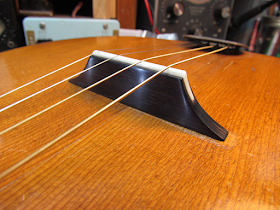Home stretch for the Regal tenor guitar.
I really didn't care for the original bridge. It was pretty homely, made out of mystery wood dyed to look like ebony, and it had ugly file marks all over it.
What to do? Why, make a new bridge!
I had recently bought a couple of African Blackwood bridge blanks on special from that well-known lutherie supply in Ohio. (Until I get an endorsement deal I shall not mention their name). This was a good opportunity to hack up a blank and see how it looked.
The Regal tenor has an archtop-style bridge on it, so it's a bit taller than a usual acoustic guitar bridge. I have a homebrew saddle slotting jig, but I couldn't use it due to the height of the bridge for this guitar.
To cut the slot, I cut a suitable smaller blank out of the blackwood, and then I clamped the blank into my trusty Workmate 200. I set the top of the blank level with the top of the Workmate.
You can see in the picture above how I used my trusty Corian fret leveling block as a fence for the router. I measured a bunch of times to make sure the fence was in the right place for the router to cut right down the middle of the blank.
Here we go. I have my Dremel mounted into the Stew-Mac Precision Routing Jig (did I say their name?) to rout the saddle slot.
I made 6 or 7 shallow passes until I got the depth where I wanted it.
This worked out ok - I just had to check that fence-to-center-of-the-blank measurement numerous times before I made my cut.
Blackwood, as it turns out, is fairly resinous. Reasonably easy to cut, but the resin and sawdust need to be cleaned out a lot. After I made a pass with the router, I had to use a screwdriver to clean out the slot - I couldn't just blow the sawdust away. The cuttings are pretty dense.
Here's the blank after slotting it. I cut it close to the actual final height and length (across the strings).
After this, I put it on the ROSS and sanded about a 10 degree angle on either side to give it a bit of a triangle shape (upward), which the original bridge had.
Next I laid out the approximate shape to cut out. The narrow part at the top will be where the saddle is. The sides with the "X" marks will be sanded to a nice curve.
I have some cylindrical spindles that fit the drill press. Handy for making nice curves.
The wood goes away fast, so you can't overdo it.
Now we fit a bone blank into the saddle slot. You can see the slot is pretty deep, so the string vibrations should really drive the bridge and in turn drive the top.
Shaping and polishing the saddle.
I rounded the top first, then fit the bridge on the guitar, tuned it up, and marked the bottom of the saddle for the action height I wanted.
Then I used the drill press sander to curve the ends of the saddle to match the curve of the bridge.
The I did the final polish with Shell A Wax after sanding the bridge up to 12000 grit paper. The bridge has a nice gloss - hard to capture in a picture.
That wood looks nice. I'd say it's a keeper.
The finished bridge installed on the guitar. You can see more of the gloss in this shot.
Only the string tension holds the bridge down, which means it's easy to move back and forth to set the intonation. And it stays that way unless you whack it out of position.
Here's the finished guitar on the workbench. It came out well. I love that aged amber color!
And a shot of the body with the new bridge. You can see what I meant by 'arch-top' style bridge. This construction was common on lower-priced instruments in the 1920s and 1930s. Less skill and precision was required for this type of construction compared to a fixed bridge with pins.
Having said that, the guitar is fairly loud and has good tone despite its small size and short scale length (21 inches). The short scale makes it effortless to play. And solid woods and a nice spruce top help it tonally.
It's tuned to the 'standard' tenor guitar tuning of C-G-D-A. I think as it gets played it will open up more.











No comments:
Post a Comment